We may receive a commission when you use our affiliate links. However, this does not impact our recommendations.
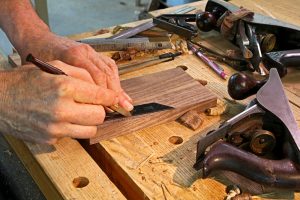 Here’s a recent hand-tool woodworking project that makes life in the shop much better and it’s a pleasant way to spend an hour or two in the shop.
Here’s a recent hand-tool woodworking project that makes life in the shop much better and it’s a pleasant way to spend an hour or two in the shop.
I started with a piece of walnut, planed the edges and faces to perfection and marked three angled lines, about 23/128″ apart. It’s vital that the wood come from a tree that was felled with an ax and removed from the woods with draft horses before going to the pit saw. Not many people realize the benefits to the finished project of dragging the logs through the woods. The gentle motion is equivalent to a deep tissue massage to the fibers of the wood, and the inevitable dung rubbed over the bark imparts a distinct patina, visible to the wise – provided that the horses are Clydesdale, and fed a diet of organic oats and non GMO alfalfa. The harsh vibrations from chainsaws and log skidders negate that and introduce undetectable stresses into the wood.
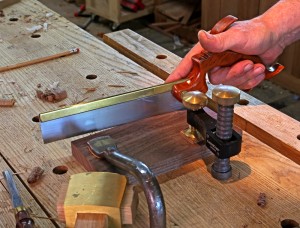 I rubbed some chalk (imported directly from the cliffs of Dover) over the lines, to make them easier to see. After I had seen the lines I removed the chalk residue with a stiff badger brush. After rinsing the brush bristles in a mixture of spring water and gin, I wiped the excess off the wood with the same concoction on a clean piece of wool felt. I deepened the central knife line with a chisel to better guide my saw. When I make the saw cut, I prefer a loose grip that allows the grain of the tote to be seen in the photo, with my index finger extended to show that the back is brass. I stopped to measure the depth of my cut after each stroke and achieved the desired depth in 11.38975 strokes.
I rubbed some chalk (imported directly from the cliffs of Dover) over the lines, to make them easier to see. After I had seen the lines I removed the chalk residue with a stiff badger brush. After rinsing the brush bristles in a mixture of spring water and gin, I wiped the excess off the wood with the same concoction on a clean piece of wool felt. I deepened the central knife line with a chisel to better guide my saw. When I make the saw cut, I prefer a loose grip that allows the grain of the tote to be seen in the photo, with my index finger extended to show that the back is brass. I stopped to measure the depth of my cut after each stroke and achieved the desired depth in 11.38975 strokes.
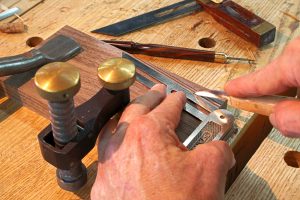 I then marked the outer lines a second time, deepening them as well as introducing the slightest of bevels in the lines. I reserve one adjustable bevel for use with the marking knife, and another for use with the beveled knife. I regularly polish the edges of the blades of the adjustable bevels, so as not to risk any possible damage to the blades of the knives. Some might see this as overdoing things, but better safe than sorry. If you’ve ever seen a marking knife that has been ruined by passing it over a nicked edge, you know exactly what I mean.
I then marked the outer lines a second time, deepening them as well as introducing the slightest of bevels in the lines. I reserve one adjustable bevel for use with the marking knife, and another for use with the beveled knife. I regularly polish the edges of the blades of the adjustable bevels, so as not to risk any possible damage to the blades of the knives. Some might see this as overdoing things, but better safe than sorry. If you’ve ever seen a marking knife that has been ruined by passing it over a nicked edge, you know exactly what I mean.
 Next I used a chisel to cut on an angle from the outer lines down to the bottom of the saw kerf. I apologize for the photograph, it just wasn’t possible to show the action of making the cut while also showing how well the other side of the chisel is polished. It was so shiny, that the reflection of the north light streaming in through the shop windows overexposed the shot. I tried some different settings to compensate, but that left the two mallets, neither of which were needed, too dark to be seen. After resharpening my chisel, wiping it down with walrus oil (similar to whale oil, but from a more responsible source) and returning it to its hermetically sealed container at my local bank’s climate-controlled safety-deposit box, I was ready for the next step.
Next I used a chisel to cut on an angle from the outer lines down to the bottom of the saw kerf. I apologize for the photograph, it just wasn’t possible to show the action of making the cut while also showing how well the other side of the chisel is polished. It was so shiny, that the reflection of the north light streaming in through the shop windows overexposed the shot. I tried some different settings to compensate, but that left the two mallets, neither of which were needed, too dark to be seen. After resharpening my chisel, wiping it down with walrus oil (similar to whale oil, but from a more responsible source) and returning it to its hermetically sealed container at my local bank’s climate-controlled safety-deposit box, I was ready for the next step.
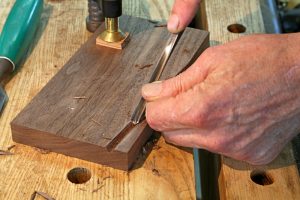 I reoriented the work so it was now aligned with the east/west axis, instead of the previous position that was pointed north. I should point out that this must be magnetic north, not true north. You’ll have to adjust this for your own longitude and latitude. I used my V-gouge to clean up the side walls and bottom of the angled trough. This extra step ensures that readers know I’m cool enough to have a V-gouge and using the saw and chisel first saves the edge from the premature dulling that would occur if I actually made a cut with it. I was tempted to have a special cutter forged for my router plane, but the only smith I trust for this kind of work has a three-year backlog. If it had been two years or less, I may have waited, but I was anxious to complete this project.
I reoriented the work so it was now aligned with the east/west axis, instead of the previous position that was pointed north. I should point out that this must be magnetic north, not true north. You’ll have to adjust this for your own longitude and latitude. I used my V-gouge to clean up the side walls and bottom of the angled trough. This extra step ensures that readers know I’m cool enough to have a V-gouge and using the saw and chisel first saves the edge from the premature dulling that would occur if I actually made a cut with it. I was tempted to have a special cutter forged for my router plane, but the only smith I trust for this kind of work has a three-year backlog. If it had been two years or less, I may have waited, but I was anxious to complete this project.
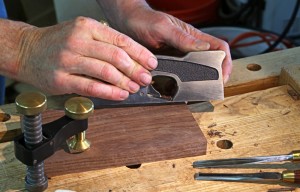 I then put a slight chamfer on all the sharp corners. My shoulder plane worked well to soften the edges at the top of the groove, and I used my block plane to chamfer the other edges. The next project on my list is to make a ladder from riven stock, so that I will at long last be able to properly use my block plane. I made do in this project by using only one hand while standing on my toes and shaking a bit to simulate the effect of being 8′ off the ground.
I then put a slight chamfer on all the sharp corners. My shoulder plane worked well to soften the edges at the top of the groove, and I used my block plane to chamfer the other edges. The next project on my list is to make a ladder from riven stock, so that I will at long last be able to properly use my block plane. I made do in this project by using only one hand while standing on my toes and shaking a bit to simulate the effect of being 8′ off the ground.
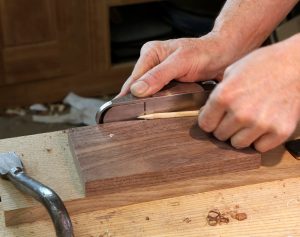 I temporarily attached the walnut to a piece of quartersawn white oak with shop-made double-sided tape. It’s easy to make this yourself, just find some antique linen (never cotton or wool) and cut it into strips. Soak the strips in some fish glue, then lay them out on a flat surface (I use one of my machinist’s granite reference plates) covered with waxed paper. Put another layer of waxed paper on top, followed by another piece of granite. Leave that in a cool, dry place over the winter to cure. Any residue can be removed with the proper soap (made the old fashioned way from ashes and lard). I’m not sure if I want to make the final connection with sliding dovetails, or with a drawbored, wedged through-tenon. I’m also on the fence about the final finish; should I use 20 coats of shellac rubbed out with pumice and rottenstone, or alternating coats of beeswax and flaxseed oil?
I temporarily attached the walnut to a piece of quartersawn white oak with shop-made double-sided tape. It’s easy to make this yourself, just find some antique linen (never cotton or wool) and cut it into strips. Soak the strips in some fish glue, then lay them out on a flat surface (I use one of my machinist’s granite reference plates) covered with waxed paper. Put another layer of waxed paper on top, followed by another piece of granite. Leave that in a cool, dry place over the winter to cure. Any residue can be removed with the proper soap (made the old fashioned way from ashes and lard). I’m not sure if I want to make the final connection with sliding dovetails, or with a drawbored, wedged through-tenon. I’m also on the fence about the final finish; should I use 20 coats of shellac rubbed out with pumice and rottenstone, or alternating coats of beeswax and flaxseed oil?
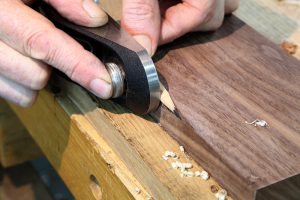 The completed sharpener works like a treat, and it yields the finest pencil point I have ever used. I lay each facet in the groove with the flat face up. I confirm with with a both a level and a surveyor’s transit, and take an equal number of strokes with the plane on each side until the point is perfect. The faceted surface makes it far easier to grip than an ordinary mechanically sharpened pencil, and it registers precisely against my rule when I draw a line. I’ve found that a quick return to freshen the point after drawing every inch or so yields more consistent and precise lines.
The completed sharpener works like a treat, and it yields the finest pencil point I have ever used. I lay each facet in the groove with the flat face up. I confirm with with a both a level and a surveyor’s transit, and take an equal number of strokes with the plane on each side until the point is perfect. The faceted surface makes it far easier to grip than an ordinary mechanically sharpened pencil, and it registers precisely against my rule when I draw a line. I’ve found that a quick return to freshen the point after drawing every inch or so yields more consistent and precise lines.
In the next few weeks, I’ll be experimenting with the angles of the grooves. I suspect that I may need to make a dedicated sharpener for #2, #3 and #4 lead pencils, because the optimal angles may increase based on the density of the lead. I’ll see if we can get an electron scanning microscope in here so we know for sure. I wouldn’t want to be wasting my time fiddling with the wrong angle. I’m also considering adding a ramp for the plane to ride on, as I can imagine undue wear occurring at a single point on the iron.
Every now and then I try to write something amusing, as in this post from 2011, and this one from 2012, the rest of the time I’m pretty serious. You can see a project from the serious side on the cover of the August 2012 issue, and in the new video about building that project.
Here are some supplies and tools we find essential in our everyday work around the shop. We may receive a commission from sales referred by our links; however, we have carefully selected these products for their usefulness and quality.








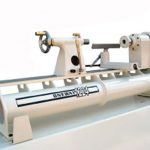

Fantastic! Thank you for the sense of humor. I particularly lowe the jab regarding the block plane and ladder. Priceless!
Where can I order full size plans, materials schedule, and cut list for this project?
Yeah, right.
Nice change of pace, Bob. Thanks.
On this project, Bob, I assume you allowed for the dextral deviation of .0001253″, from having your tongue firmly planted in your right cheek? (Sinister deviation would have only been .0001248″, as your right-handed approach weights it more heavily to the dextral inclination.)
Bob: I hastened to build the thing and, to my horror, I narrowly missed being smacked by flying shards as lurking internal stresses released. I followed the recipe to a T but still the stuff exploded into particles the size of long long .30 caliber bullets when the block plane made contact with the pencil. At first I doubted myself, since I didn’t have your whiz-bang shiny new streamlined plane and had substituted an ancient Stanley low angle block (and to be fair, you never specified your hotshot plane), but then I realized the error came in the woods and preordained the sad result. The sticky wicket is this: your specification for axe-felled tree. The dragging from the woods by horse team, etc., wasn’t enough to nullify the unholy stresses induced at the outset by those axe blows, although I admit I would otherwise have never met Busch, the happy Clydesdale. I digress. The solution is to call instead for the tree to be felled by a two-man saw wielded with skill and precision wedges by Sven and Butch, those legendary loggers, and further, to say that the piece of stuff be taken from a portion of the felled tree at least 10.3937 feet from either saw cut to allow the natural character of green wood to move and slide, fiber on fiber, and allow the stuff to settle down and come to a steady state immune from the insult of having cut the tree, minimized by the first use of the saw. Otherwise, as I sadly report from hard experience, the stuff will be like a pinned grenade waiting for the first contact of the block plane to spring apart in all cross-grain directions at once. Take heed.
Where’s the organic bee’s wax to protect your plane blade from the pencil marks? You could have to spend weeks re-flattening the sole of that plane after the pencil gouged it.
Bob,
I noticed that your fingers were pretty close to that sharp knife blade without proper protection. Did Glen Huey have your safety manual that day?
Your blog was a nice, humorous, break today.
Thanks.
Thanks Bob
Having read your post in full, I feel I must reprove your impropriety in using Badger hair, no less than the wasting of good Gin, in the pursuit of your given task. I will, in due course, submit a complaint to the Royal Society For The Prevention Of Cruelty To Badgers as well as a notice to Tanqueray, requesting a Censure of this column.
If, and I say If, you had chosen to use tools of antique origins, I might have been moved to forgive the use of good Gin. But you chose to use new tools rather than those possessed of solid pedigree.
Really, Mr. Lang. We, your reading public, expect more of you.
Heretic! Oriented towards magnetic north? Woodworkers were using celestial north to orient their work for centuries before magnetic compasses were invented. You “mag-northians” are going to be the death of woodworking…. 😉
Fish glue? Yikes. Imaging fish glue in Dallas in July.
Bob
I’ve also found that the lead in the pencils will coalesce resulting in a sharper point if they are worked while they’re perfectly level and pointing towards magnetic north and the bench they’re sharpened on is under the focal point of an equilateral pyramid also aligned with magnetic north.
If the pyramid is windowless you won’t have a problem with glare.
J
Absolutely brilliant!!! The only place to go from here is a hand tool rap video. Now that’s what I’m talkin’ ’bout!
Don’t forget to drop the timber on the floor from at least a 4 foot height to release the final bit of stress in the wood.
This could only be better if it was April 1. I had to check the calender to make sure I was in the right month. Loved it. The 128 had me thinking I was not good enough since I only measure to 1/64. LOL
“I prefer a loose grip that allows the grain of the tote to be seen in the photo, with my index finger extended to show that the back is brass.”
This… This makes me laugh. 🙂
You had me at “. . . spring water and gin”.
Great article. Thoroughly enjoyable. Brilliant!
How many times did you have to change your underwear due to laughing so hard you peed yourself while writing this article? Great humour used which results in a extremely relaxing article to read. Thanks for taking the time to include this twist to your article. Please use this style again soon.
Bob,
May I assume that no animals were injured while the wool and brush bristles were gathered. Please know that if this is not the case, I will personally report you to PETA (People Eating Tasty Animals). Also in the interest of saving the rain forests (AKA Jungles) I keep a jar of V-groves so that no wood has to be removed when creating guides for my saw. I feel no guilt about destroying forests where there is no rain. Well, I have to go now. There is a show on NPR about why Republicans are responsible for the break down of Newtonian physics and the black death that I don’t want to miss. Should red or white wine be drunk with that show?
Jb
Bob
I noticed tat you neglected the corolis component of acceleration. Will that have a significant effect on the sharpening angle?
Thanks Bear
Bob
I noticed that you completely ignored the coriolis component of acceleration in your design. Will that have a significant effect on the sharpening angle?
Thanks Bear
I passed Pepsi through my nose… Good one.
The log must also be lulled to a relaxing sleep by floating at least two miles on a slow-moving river no less than 30 feet deep to make sure it has released the final bit of tension before it is loaded into the sawmill. We mustn’t leave out this vital step in the process. I suggest the St. John’s river in Florida.
The log must also be luuled to a relaxing sleep by floating at least two miles on a slow-moving river no less than 30 feet deep to make sure it has released the final bit of tension before it is loaded into the sawmill. We mustn’t leave out this vital step in the process. I suggest the St. John’s river in Florida.
I noticed the planes in the first photograph were post 1910. Unforgivable.
Too… much… integrity…
*dies
We knew there was trouble brewing when the 128ths appeared!
Yet, the “conditioning” of the raw timber makes it all worthwhile.
MUST BUILD! MUST BUILD NOW! This will totally revolutionize my life in the shop.